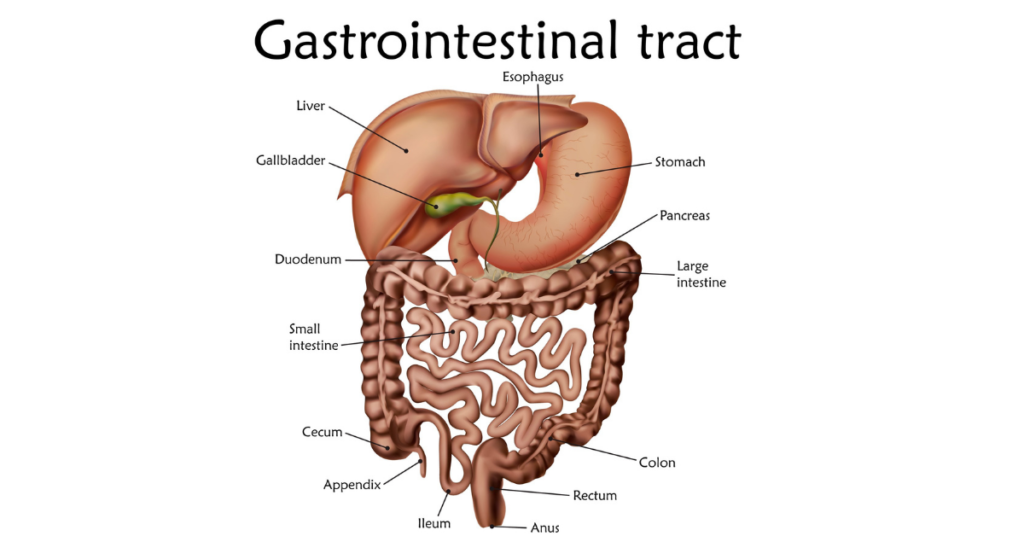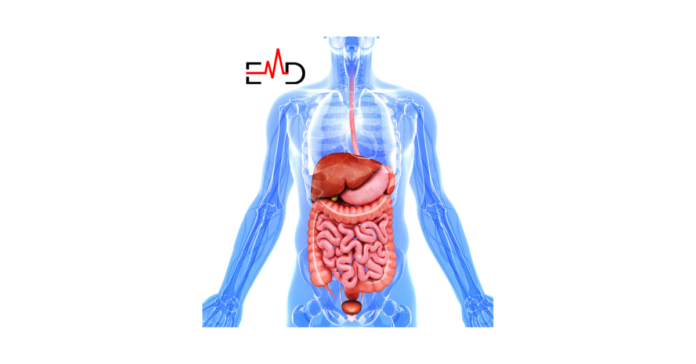Table of Contents
Exercise Daily – wondering about what is the main function of the digestive system? Well, you are not alone. A lot of people come up with this question in mind. So, let’s find out.
But, before moving forward to the functions of the digestive system, let’s take a look at what it is and how it works. So, let’s dig into it.
Do you know the food you eat makes a remarkable journey through your body — from the top (mouth) to bottom (anus)? Along the journey, your body absorbs the essential nutrients from the food, providing you energy and nutrients.
What is Digestive System?

The digestive system is composed of organs that work together to transform food into energy and essential nutrients. These nutrients are then used to nourish the entire body.
Food travels through the alimentary canal, also known as the gastrointestinal tract, which is a lengthy tube inside the body (GI tract). The oral cavity, pharynx, esophagus, stomach, small intestines, and large intestines are all part of the alimentary canal.
Apart from the alimentary canal, there are numerous vital accessory organs that assist your body digest food, but the food doesn’t pass through them. Teeth, tongue, salivary glands, liver, gallbladder, and pancreas are some of the digestive system’s accessory organs.
Now, before moving towards our main topic, “what is the main function of the digestive system” let’s take a look at the working of the digestive system.
Structure and Working of Digestive System
Let’s take a look at the working of the digestive system. Please go through the illustrations so you can understand the working process properly:
Mouth
The mouth, commonly known as the oral cavity, is where food begins its journey through the digestive system. Moreover, the tongue, teeth, and salivary glands are just a few of the accessory organs present inside the mouth that help in food digestion.
Food is chopped into little bits by the teeth, which are moistened by saliva before being pushed into the pharynx by the tongue and other muscles.
Pharynx
The pharynx, commonly known as the throat, is a funnel-shaped tube that connects the mouth to the back end. Moreover, the pharynx is in charge of transporting large amounts of chewed food from the mouth to the esophagus.
It is particularly important in the respiratory system as well because the air from the nasal cavity flows through it on its route to the larynx and then to the lungs.
The pharynx contains a flap of tissue known as the epiglottis that acts as a valve to send food to the esophagus and air to the larynx since it performs two functions.
Esophagus
The esophagus is a muscular tube in the upper gastrointestinal system that connects the pharynx to the stomach. It travels the length of the body, carrying swallowed chunks of chewed food.
Additionally, the lower Stomach, Gallbladder, and Pancreasesophageal Sphincter (or cardiac sphincter) is a muscular ring located at the inferior end of the esophagus. This sphincter’s job is to shut the esophagus’s end and keep food trapped in the stomach.
Note: Do not mix Esophagus with your question about what is the main function of the digestive system. It is mainly involved in the digestion process and not the function.
Stomach
Now, finally comes the stomach (the most important area of digestion). The stomach is a muscular sac that lies directly underneath the diaphragm on the left side of the abdominal cavity.
The stomach of the average individual is around the size of two fists placed next to each other. This important organ serves as a food storage tank, giving the body enough time to adequately digest substantial meals.
Hydrochloric acid and digestive enzymes are also present in the stomach and continue the digestion of food that initially started in the mouth.
Small Intestine
The small intestine is 1 centimeter in diameter and around 10 feet long and a long, thin tube that lies in the lower gastrointestinal tract. It is situated below the stomach and occupies most of the abdominal cavity.
The whole intestine is wrapped like a tube, and the inner surface is full of ridges and folds. These folds are employed to optimize food digestion and nutrient absorption.
When food leaves the small intestine, approximately 90 percent of all nutrients were taken from the food that came into it.
Liver and Gallbladder
The liver is an anatomically triangular digestive system organ on the right of the stomach, directly below the diaphragm and above the small intestine.
The liver has many diverse activities in the body. But in digestion, the bile and its secretion in the small intestine are the principal functions of the liver. The gallbladder is a tiny, pear-shaped organ just behind the liver.
The gallbladder helps to retain and recycle excess bile from the small intestine so that it can further use in food digestion.
So, it is important to note that when you talk about what is the main function of the digestive system, the Liver and Gallbladder also play an important role in it.
Pancreas
The pancreas is a big gland right below and back to the stomach. It is approx. 6″ long and formed like a small, lumpy snake with a “head” connected with the duodenum and a “tail” to the left wall of the abdominal cavity.
In order to complete the digestion of food, the pancreas secretes digestive enzymes in the small intestine.
Large Intestine
The large intestine is around 2.5 inches in diameter and 5 feet long with a long, thick tube. It is slightly below the stomach and wraps the upper and lateral edges of the small intestine.
The large intestine collects water and contains several symbiotic bacteria that help to break down waste in order to collect modest quantities of nutrients. Feces leave the body in the large intestine via the anal canal.
What is the Main Function of the Digestive System?
The digestive system is mainly responsible for the digestion of food. However, it has major six functions, including:
Ingestion
Ingestion or the intake of food is the initial function of the digestive system. This is the role of the mouth, as it is the opening via which all food enters the body.
The mouth and stomach are also crucial for storing food while waiting for digestion. This capability permits the body to eat just a few times a day.
Secretion
Once per day, roughly 7 liters of fluids are secreted in the digestive system. Enzymes, mucus, hydrochloric acid, and bile are among those fluids. Saliva moisturizes dry food and contains salivary amylase, an enzyme that initiates carbohydrate digestion.
However, inside the GI system, Mucus serves as a protective barrier and lubricant. Hydrochloric acid aids in the chemical digestion of food and protects the body by killing microorganisms in our meals.
Enzymes are like smaller biochemical systems disassembled into their smaller components big macromolecules such as proteins, carbohydrates, and lipids.
Mixing and Movement
When we talk about what is the main function of the digestive system, mixing and movement is the most important function. The digestive system uses three key processes for moving and mixing food:
Swallowing
Swallowing is a procedure in which you use smooth and skeletal muscles to force food out of the mouth through the pharynx and the esophagus in the mouth, tongue, and throat.
Peristalsis
Peristalsis is a muscle wave that runs down the GI tract. It transports partly digested food within a small distance of the tract. For food to travel from the esophagus, stomach, and intestine, it takes numerous waves of peristalsis to reach the end of the GI tract.
Segmentation
Segmentation only happens in the gut as short segments of the gut contract, such as the hands squeezing the tube of toothpaste. It helps to promote nutrient absorption by mixing food and increase interaction with the intestinal walls.
Digestion
Digestion is the process of transforming big meal parts into chemical components.
Mechanical digestion is the physical breakdown into smaller bits of large foods. This digestive mode starts with the chewing of food with the teeth and continues with the muscular mixing of the food with the stomach and intestines.
The liver bile helps in splitting lipids into smaller globules mechanically. While food is mechanically digested, it is also chemically digested as larger and more complicated molecules are broken up into more easily absorbed smaller molecules.
Digestion starts with salivary amylase in the mouth, which divides large molecules of carbohydrates into simple carbohydrates.
Enzymes and the acid in the stomach continue to digest chemically, although a large part of the chemical digestion occurs through the pancreas in the small intestine.
Additionally, the pancreas secretes an extraordinarily intense digestive mixture known as pancreatic juice. It can digest lipids, carbs, proteins, and nucleic acids.
Due to these large number of processes taking place in the digestion phase, it is the main function when we talk about what is the main function of the digestive system.
Absorption
Absorption starts in the stomach with the direct absorption of simple molecules such as water and alcohol into the bloodstream.
Small blood and lymph vessels in the intestinal wall collect and take the molecules to the rest of the body. The large intestine also absorbs water, vitamins B and K before the feces exit the body.
Excretion
The last function of the digestive system is to excrete waste in a process called defecation. Defecation removes indigestible materials from the body to prevent them from building up inside the intestines.
The conscious part of your brain freely controls the time of feces. However, to avoid the buildup of indigestible materials, you should regularly do it.
How Digestive System and Immunity are Linked?
Do you know that around 70% of your immune system is housed in your gut?
When food is broken down by thorough digestion, your stomach works to absorb nutrients required to provide a variety of physiological functions and eliminate waste from your body.
So, here the question is if your digestive system and Immunity are linked then how can you boost your immune system through your gut?
Well, there are multiple ways to boost your immune system through your gut, but we have listed down some Do’s and Don’ts that will help you to maintain a healthy immune system:
Do’s
- Eat organic natural food
- Drink plenty of water and fresh juices
- Eat vegetables, fruits salads daily
- Eat sweets alternatives like dates, raisins, dried figs, etc.
- Have 4 to 6 small meals a day
Don’ts
- Avoid all food that contains preservatives, artificial flavors
- All Processed food
- Too much meat in the diet
- Fried foods, fries, or junk food
- Too many sweets, sugar
- Sodas all together
- Alcohol
What is the Main Function of the Digestive System – FAQs
What is the Most Important Function of Digestion?
For breaking the food into nutrients, digestion is crucial, as the body uses them to generate energy, growth, and cell repair.
Moreover, the blood absorbs only smaller molecules of nutrients and then delivers them through the body.
What is the Main Part of the Digestive System?
The mouth, esophagus, stomach, small intestines, large intestine, rectum, and anus are the primary organs that make up the digestive system (in order of their function). Pancreas, gallbladder, and liver support them along the route.
What are the 2 types of Digestion?
Digestion is a sort of catabolism or the decomposition of different substances involving: mechanical digestion and chemical digestion.






